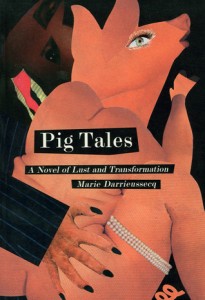
First edition cover of Marie Darrieussecq’s Pig Tales. Originally published as Truismes (Paris, 1996)
The main protagonist of Marie Darrieussecq’s novel finds herself inexplicably slowly transforming into a porcine animal. When reading novel an immediate question is raised to us as readers: Why a pig in particular? The pig is not a diametrically opposed to us like an invertebrate or a cold blooded reptile or amphibian. But then a pig is equally not as easy for us to relate to as a more humanoid animal (such as an ape) or a more essential domestic animal (such as a horse or a dog).
Sarah Dunant (writing for the Observer) summarised one aspect of the choice of a pig to metamorphosize into: ‘If all men are pigs, then what can a woman do but turn into a sow?’ Marie Darrieussecq was writing in a time in which feminism was entering what is commonly described as its third wave. The feminism of the 1990s was much more bodily-representational than previous incarnations, focusing on the reproductive rights of women and to a certain extent the aestheticism of the female body among other issues.
The nature of the pig is a major consideration in the choice of the animal into which the protagonist transforms. Pigs are naturally docile animals that are farmed and specifically bred for consumption by humans. Many parallels can be drawn between this and the lifestyle of the sex worker that the protagonist finds herself drawn to. The form of a pig is a stark contrast to the wolf like form that Yvan is transformed into with its predatory connotations.
Alongside the feminist aspect, another political change was taking place in France in the 1990’s. France (due to its proximity to northern Africa) has continuously considered its approach, stance and response to Islam and Islamic culture. The Algerian war of independence (in which France was the colonial power) had brought this into sharp focus, specifically whether Islam was compatible with French culture. This came to a head in the 1990s when the Front National came very close to winning the presidential elections.
The pig is particularly significant in respect to Islam as it is one of the meats that are considered Haraam, not fit for consumption by humans. This, when combined with the far-right revolution in the novel that oppresses the Islamic community, enables us to see that one of the fears in the novel is the oppression of such Islamic minorities. France had as recently as 1945 seen the effects of far right politics on the Jewish community (who incidentally also forbid the consumption of pig meat).
The transformation of the protagonist into a pig is in hindsight the natural choice for the novel. We find that political implications as well as the social and physical implications provide a basis to inform us readers of a harsh reality that could so easily occur.
Reuben Bennett
2nd Year Undergraduate
Member of the ‘Twentieth Century Literature and Science: Remaking the Body’ module

1 ping
[…] & the 19th century stomach Environmental History’s Growing Pains On Marie Darrieussecq – Pig Tales (London, 1998) The links between science studies and British “declinist” discourse All Environmental Politics […]